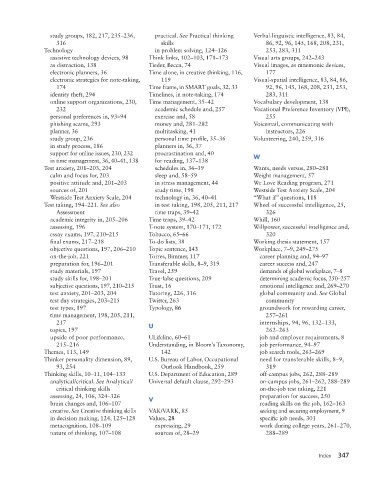Page 384 - Keys to College Success
P. 384
study groups, 182, 217, 235–236, practical. See Practical thinking Verbal-linguistic intelligence, 83, 84,
316 skills 86, 92, 96, 145, 168, 208, 231,
Technology in problem solving, 124–126 253, 283, 311
assistive technology devices, 98 Think links, 102–103, 171–173 Visual arts groups, 242–243
as distraction, 138 Tieder, Becca, 74 Visual images, as mnemonic devices,
electronic planners, 36 Time alone, in creative thinking, 116, 177
electronic strategies for note-taking, 119 Visual-spatial intelligence, 83, 84, 86,
174 Time frame, in SMART goals, 32, 33 92, 96, 145, 168, 208, 231, 253,
identity theft, 294 Timelines, in note-taking, 174 283, 311
online support organizations, 230, Time management, 35–42 Vocabulary development, 138
232 academic schedule and, 257 Vocational Preference Inventory (VPI),
personal preferences in, 93–94 exercise and, 58 255
phishing scams, 293 money and, 281–282 Voicemail, communicating with
planner, 36 multitasking, 41 instructors, 226
study group, 236 personal time prof le, 35–36 Volunteering, 240, 259, 316
in study process, 186 planners in, 36, 37
support for online issues, 230, 232 procrastination and, 40 W
in time management, 36, 40–41, 138 for reading, 137–138
Test anxiety, 201–203, 204 schedules in, 36–39 Wants, needs versus, 280–281
calm and focus for, 203 sleep and, 58–59 Weight management, 57
positive attitude and, 201–203 in stress management, 44 We Love Reading program, 271
sources of, 201 study time, 198 Westside Test Anxiety Scale, 204
Westside Test Anxiety Scale, 204 technology in, 36, 40–41 “What if” questions, 118
Test taking, 194–221. See also in test taking, 198, 205, 211, 217 Wheel of successful intelligence, 25,
Assessment time traps, 39–42 326
academic integrity in, 205–206 Time traps, 39–42 Whill, 160
assessing, 196 T-note system, 170–171, 172 Willpower, successful intelligence and,
essay exams, 197, 210–215 Tobacco, 65–66 320
f nal exams, 217–218 To-do lists, 38 Working thesis statement, 157
objective questions, 197, 206–210 Topic sentence, 143 Workplace, 7–9, 249–275
on-the-job, 221 Torres, Bimmer, 117 career planning and, 94–97
preparation for, 196–201 Transferable skills, 8–9, 319 career success and, 247
study materials, 197 Travel, 259 demands of global workplace, 7–8
study skills for, 198–201 True-false questions, 209 determining academic focus, 250–257
subjective questions, 197, 210–215 Trust, 16 emotional intelligence and, 269–270
test anxiety, 201–203, 204 Tutoring, 226, 316 global community and. See Global
test day strategies, 203–215 Twitter, 263 community
test types, 197 Typology, 86 groundwork for rewarding career,
time management, 198, 205, 211, 257–261
217 internships, 94, 96, 132–133,
topics, 197 U 262–263
upside of poor performance, ULifeline, 60–61 job and employer requirements, 8
215–216 Understanding, in Bloom’s Taxonomy, job performance, 94–97
Themes, 113, 149 142 job search tools, 263–269
Thinker personality dimension, 89, U.S. Bureau of Labor, Occupational need for transferable skills, 8–9,
93, 254 Outlook Handbook, 259 319
Thinking skills, 10–11, 104–133 U.S. Department of Education, 289 off-campus jobs, 262, 288–289
analytical/critical. See Analytical/ Universal default clause, 292–293 on-campus jobs, 261–262, 288–289
critical thinking skills on-the-job test taking, 221
assessing, 24, 106, 324–326 V preparation for success, 250
brain changes and, 106–107 reading skills on the job, 162–163
creative. See Creative thinking skills VAK/VARK, 85 seeking and securing employment, 9
in decision making, 124, 125–128 Values, 28 specif c job needs, 301
metacognition, 108–109 expressing, 29 work during college years, 261–270,
nature of thinking, 107–108 sources of, 28–29 288–289
Index 347

